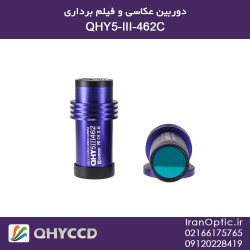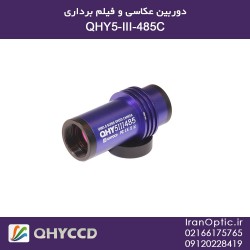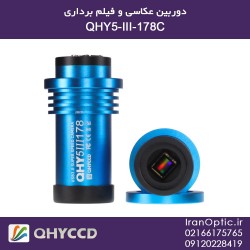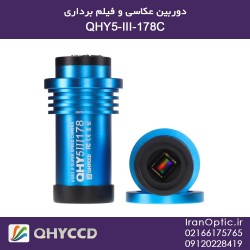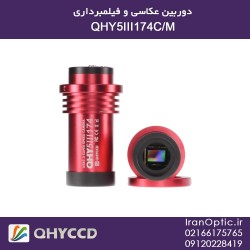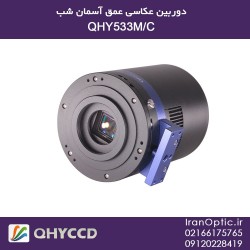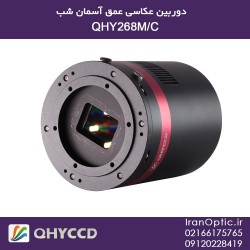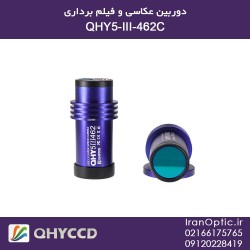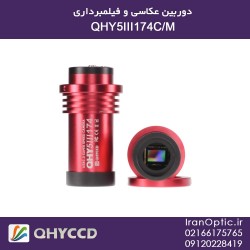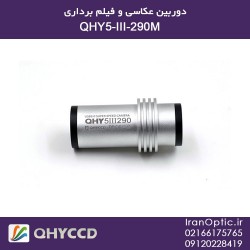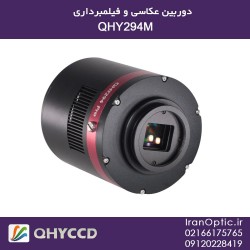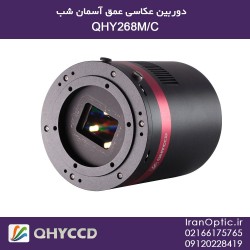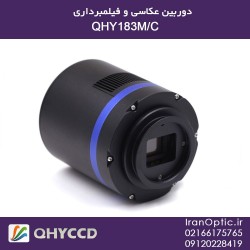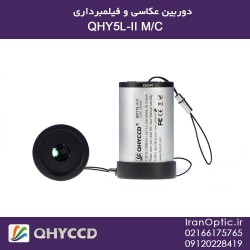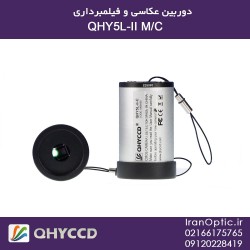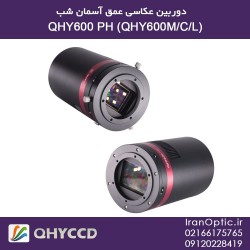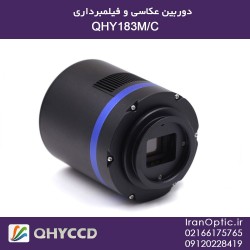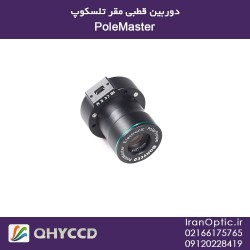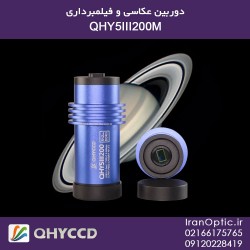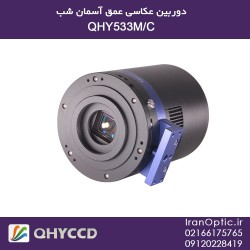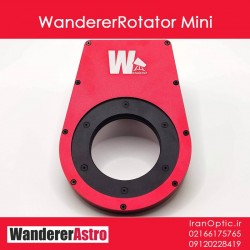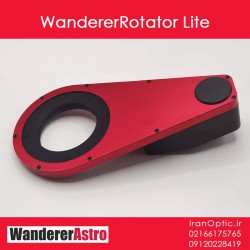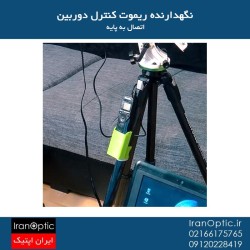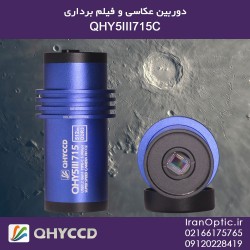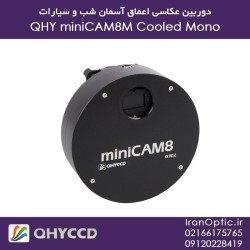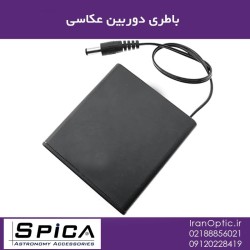فروشگاه تلسکوپ، دوربین عکاسی، ابزارهای رصدی، آسمان نما، رصدخانه، مناسب دانشآموزان و دانشجویان، بهترین قیمتها، ارزان و حرفهای، به همراه مشاوره و راهنمایی پیش و پس از خرید.

هیچ محصولی وجود ندارد
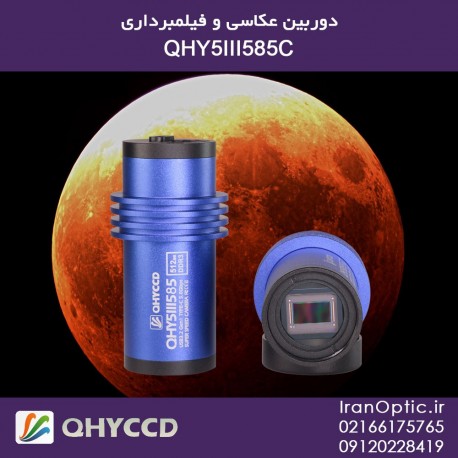 نمایش بزرگتر
نمایش بزرگتر فقط آنلاین
QHY5III585C
محصول جدید
By buying this product you can collect up to 3000000 loyalty points. Your cart will total 3000000 loyalty points that can be converted into a voucher of 600,000 تومان.
- Remove this product from my favorite's list.
- Add this product to my list of favorites.
- ارسال به یک دوست
- چاپ
اطلاعات بیشتر
QHY5III585C is a new generation of QHY5III V2 series planetary guide camera, which is an enhanced version of its predecessor QHY5III485C. It has a high sensitivity in the near infrared similar to that of 5III462C, while the dynamic range performance has been greatly improved. It has a 1/1.2-inch large sensor and excellent characteristics of zero glow.
The product comes with filters including an IR850nm filter.
In this latest generation of sensors, the photodiode portion of the pixel well is physically deeper than in previous sensors, allowing photons of longer wavelengths to penetrate deeper into the substrate. This dramatically increases the sensor’s sensitivity to red and near-infrared (NIR) light. The sensor displays almost equal peak sensitivity to NIR light as it does to light in the visible spectrum.
 One benefit of the back-illuminated CMOS structure is improved full well capacity. In a typical front-illuminated sensor, photons from the target entering the photosensitive layer of the sensor must first pass through the metal wiring that is embedded just above the photosensitive layer. The wiring structure reflects some of the photons and reduces the efficiency of the sensor.
One benefit of the back-illuminated CMOS structure is improved full well capacity. In a typical front-illuminated sensor, photons from the target entering the photosensitive layer of the sensor must first pass through the metal wiring that is embedded just above the photosensitive layer. The wiring structure reflects some of the photons and reduces the efficiency of the sensor.
In the back- illuminated sensor the light is allowed to enter the photosensitive surface from the reverse side. In this case the sensor’s embedded wiring structure is below the photosensitive layer. As a result, more incoming photons strike the photosensitive layer and more electrons are generated and captured in the pixel well. This ratio of photon to electron production is called quantum efficiency. The higher the quantum efficiency the more efficient the sensor is at converting photons to electrons and hence the more sensitive the sensor is to capturing an image of something dim.
The IMX585 is a Sony Starvis II processor that enables high sensitivity and high dynamic range (HDR). It also improves sensitivity in the near-infrared range by approximately 1.7 times* compared to the IMX485. The new camera QHY5III585C has a large fullwell capacity of over 30ke-, approximately three times that of the previous generation QHY5III485C.
*This data is officially provided by Sony: https://www.sony-semicon.com/cn/news/2021/2021062901.html
The QHY5III (Ver. 2) series planetary and guiding cameras are all equipped with a 512MB DDR3 image buffer which can effectively reduce the pressure on computer transmission, a great help for planetary photography which often requires writing a large amount of data in a short period of time. Some deep-sky astrophotography cameras on the market today only have 256MB, for example.
In comparison, the 512MB DDR3 memory of the new 5III (Ver. 2) series cameras represents a significant upgrade.
QHY5III (Ver. 2) series cameras have adopted a new front-end design with better compatibility. The new front end supports 1.25″ interface of telescopes and is also compatible with CS-port lenses and C-port lenses, and can shoot with C/CS-port lenses with filters attached.
A 1.25″ framed filter can be fitted with the front end, and a frameless filter can be fitted on the front part of the upper CMOS. The size of the filter glass that is compatible here varies depending on the size of the sensor, but is basically a standard lab filter specification. Compared to the more expensive astronomical filters, lab filters tend to be less expensive and have a wider variety of bands, allowing you to develop more uses and applications for them.
The new QHY5III (Ver.2) series cameras all use the USB3.2 Gen1 Type-C interface. Compared to the USB3.0 Type-B interface used in the previous generation, the Type-C interface has a longer life and is more flexible.
Tips: It is recommended to use the official standard Type-C data cable of QHYCCD. As the market is flooded with a large number of poor-quality Type-C cables, casual use may lead to the camera malfunctioning. If you use your own spare cable, please make sure it is a high-quality cable.
The custom interfaces of the previous generation of planetary cameras and guiders has been replaced in the QHY5III (Ver.2) cameras with a more universal ST-4 compatible guiding interface. Now, even if the guiding cable is lost or damaged, you will be able to easily get a replacement on the market at a low cost.
 The new QHY5III (Ver.2) series of cameras is equipped with a status indicator at the back of the camera. If the camera experiences an abnormal status, the multi-colored indicator light will help to determine the situation with different colors signifying different conditions. During normal operation this indicator light is off, so there is no worry about light contaminating the image.
The new QHY5III (Ver.2) series of cameras is equipped with a status indicator at the back of the camera. If the camera experiences an abnormal status, the multi-colored indicator light will help to determine the situation with different colors signifying different conditions. During normal operation this indicator light is off, so there is no worry about light contaminating the image.
| Model | QHY5III585C |
| CMOS Sensor | Sony IMX585 BSI Sensor |
| Pixel Size | 2.9um*2.9um |
| Effective Pixel Area | 3856*2180 |
| Effective Pixels | 8.4 Mega Pixel |
| Sensor Size | 1/1.2inch |
| Fullwell Capacity | 32ke- |
| Readout Noise | 0.8-5.5e- |
| AD Sample Depth | 12-bit (output as 16-bit and 8-bit) |
| Built-in Image Buffer | 512MB DDR3 Memory |
| ROI Frame Rate | Full Resolution 41.5FPS @8BIT 23.5FPS @16BIT 1920Lines 82FPS @8BIT 47FPS @16BIT 640Lines 177FPS @8BIT 106FPS @16BIT |
| Exposure Time Range | 11us-900sec |
| Shutter Type | Electronic Rolling Shutter |
| Computer Interface | USB3.2 Gen1 Type-C |
| Guide Port | st4 |
| Telescope Interface | 1.25-inch, compatible with CS interface or C interface by changing the front-end connector (An IR-Cut filter and an IR850nm filter are included in the standard version) |
| Back Focal Length | 17mm |
| Weight | 90g |
Reviews
No customer reviews for the moment.












